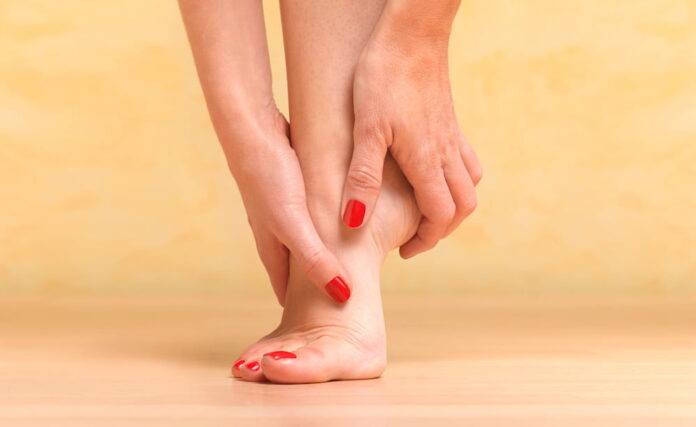Between standing, walking and exercising, our feet can become tired or sore after a while. While you should always seek professional medical help should symptoms be severe, there are some natural or at-home solutions you can try to help reduce the pain.
Here we’ve come up with four remedies to help relieve the soreness in your feet and have you back to normal in no time.
Walking Barefoot
Ditching your everyday shoes can be highly beneficial for improving foot circulation and aiding the nourishment of muscles, bones and nerves. It can also ease and reduce swelling.
In addition, it has the potential to improve the strength and flexibility of the ligaments and muscles of the foot. This has been linked to an improvement in posture and balance and a reduction in injuries.
Start walking barefoot on soft surfaces like grass, sand and carpet, so as not to injure the feet further. If it’s a nice dry day outside, go for a short walk outside and stop if you begin to feel any pain. If you don’t feel comfortable walking totally barefoot, a pair of barefoot shoes can alleviate this problem whilst still providing the same benefits.
Soak the Feet
Soaking the feet in a warm foot bath can be soothing, so long as the water isn’t too hot. Adding Epsom salts can help to relieve sore muscles and can also reduce any swelling. You can make an Epsom foot bath by simply adding one cup of Epsom salts to lukewarm water.
Submerge the feet and soak for around 20 minutes. Make sure to properly moisturise the feet afterward to ensure they don’t become irritated or cracked.
Stretch and Repeat
Doing some basic stretching each day can help to reduce soreness. You can target specific areas like the heel or your toes or you can focus on the entire foot. The following exercises are great for increasing flexibility and reducing cramping:
– Flex the toes, pointing them outward and curl them for a few seconds. Aim to repeat this ten times
– Sit down and extend your legs. Move the toes around. Point the toes toward your body and then away. Then, move the ankles in clockwise and anti-clockwise circles
– Stretch the feet by moving your weight from your heel to your toes. Do this by lifting the back of your feet off the ground using the front while standing
The RICE Method
If your foot pain is a result of injury, RICE may be necessary. This is particularly beneficial for ankle sprains. These simple self-care steps are effective in reducing pain and swelling and speeding up the healing process:
Rest – Make sure to take pressure off the injured foot to avoid further injury
Ice – Apply an ice pack to the injured area and leave for 20 minutes
Compression – Use an elastic wrap to prevent and control swelling
Elevation – Raise the foot and ankle slightly, if possible, to avoid swelling
Read Also
- Understanding the Importance of Routine Health Screenings for SeniorsDid you know that the global routine health screening market is expected to reach $105.93 billion by 2033? This highlights the rising focus on preventive healthcare. As we age, our bodies go through many changes. Staying proactive about health becomes more important with time. Routine health screenings for seniors play a vital role in maintaining… Read more: Understanding the Importance of Routine Health Screenings for Seniors
- Why Modern Retirement Facilities Are Vital for Chronic Disease CareToday’s retirement feels different from the past. Modern communities are bright, active, and full of life. They give seniors comfort while also providing the care needed for health and safety. For those living with long-term conditions like diabetes or heart disease, these places bring both support and peace of mind. Here, life doesn’t slow down-it… Read more: Why Modern Retirement Facilities Are Vital for Chronic Disease Care
- Understanding Breast Cancer Risks and Signs in Older MenMany people associate breast cancer with women. But did you know that breast cancer risk in older men is a significant health concern? Although it is rare, men can develop this disease, especially in later years. Understanding the risks, symptoms, and necessary preventive actions can lead to earlier detection and treatment, ultimately improving survival rates.… Read more: Understanding Breast Cancer Risks and Signs in Older Men
- How to Choose the Perfect Eyewear for Your Face Shape and StyleEyewear has evolved far beyond a simple vision aid—today, it’s a bold statement of personality, professionalism, and fashion sense. Whether you’re selecting your first pair or updating your look, the right frames can enhance your features, elevate your confidence, and even influence first impressions. But with endless options available, how do you find the perfect… Read more: How to Choose the Perfect Eyewear for Your Face Shape and Style
- How to Choose the Right Senior Living Community for Your NeedsHow do you know which senior living community fits your needs best? Choosing the right place can feel tricky with so many options, from independent living to assisted care. It’s important to think about daily routines, medical support, social activities, and the kind of environment that feels safe and welcoming. You also want a place… Read more: How to Choose the Right Senior Living Community for Your Needs
- Breast Cancer Prevention: The Role of Regular ExerciseIn a world where health challenges loom large, the call for proactive steps towards wellness has never been louder. One powerful ally in the fight against breast cancer is regular exercise-a proven strategy that works wonders not just for physical well-being but also for mental resilience. In this article, we delve into how exercise contributes… Read more: Breast Cancer Prevention: The Role of Regular Exercise







